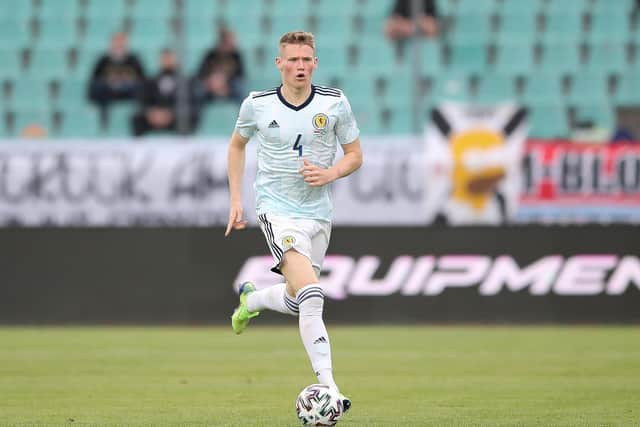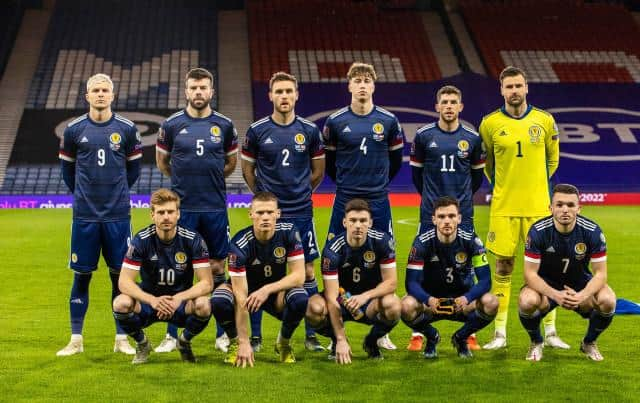Euro 2020: From Wishaw Wycombe Wanders and Highfield Rangers to major tournament - the journey taken by all 26 Scotland players


Ahead of Scotland’s momentous return to the main international stage against Czech Republic at Hampden on Monday, we take a look at where each of Clarke’s 26 players began their careers.
Craig Gordon
It’s now over three decades since Gordon’s talent first emerged with Currie Boys Club in the south west of Edinburgh. Quickly snapped up by the Hearts youth set-up, a loan spell at Cowdenbeath toughened him up for the rigours of senior football and the rest is history. At 38, he is still performing at an outstanding level with Hearts and bidding to add to his 57 Scotland caps.
David Marshall
Advertisement
Hide AdAdvertisement
Hide AdThe hero of Scotland’s Euro 2020 play-off win in Serbia was first spotted by Celtic scouts while playing school football for St Thomas’ Primary in Riddrie in the north east of Glasgow. He joined the Celtic academy before leaving school and his breakthrough moment came with a brilliant display against Barcelona in the Nou Camp when he was 19. Now 36, Marshall is the man in possession of the gloves for Scotland going into Euro 2020.
Jon McLaughlin
The Rangers goalkeeper took an unconventional route in the game after his family left his Edinburgh birthplace when he was just one year old to live in Saudi Arabia where his first experiences of football at school were shared with basketball and hockey. McLaughlin returned to the UK to live in Leeds when he was 11 and emerged through the Harrogate Railway FC academy. Before stepping into the senior ranks at Bradford City, he helped Great Britain reach the semi-finals of the football tournament at the 2009 World Student Games in Belgrade.


Liam Cooper
The Leeds United captain is a product of the Hull City youth academy which he joined at the age of 11 while at the city’s noted Malet Lambert School. Cooper, who qualifies to play for Scotland through his paternal grandfather from Bo’ness, has been part of the country’s international set-up since making his debut for the under-17 side back in 2008.
Declan Gallagher
The Aberdeen-bound centre-half started out with Blantyre Boys Club in South Lanarkshire at the age of seven. After a brief spell in the Hamilton Accies academy, he moved to the youth set-up at Celtic where he was unable to make a first team breakthrough before being released when he was 20.


Grant Hanley
Dumfries-born Hanley began his career in the youth set-up at local club Queen of the South before joining the Crewe Alexandra academy when he was 13. Two years later, he returned to Scotland for a spell in the Rangers academy before being signed by Blackburn Rovers on a professional youth contract in 2008.
Jack Hendry
From Glenafton Athletic to scoring against the Netherlands is quite the quantum leap. Hendry started out with the Ayrshire junior club’s under-8 side where he attracted the attention of the Celtic academy which he joined as a 10-year-old. His senior breakthrough came at Partick Thistle in 2015.


Scott McKenna
While playing for the Webster’s High School team in Kirriemuir and local junior club Kirrie Thistle, McKenna was recruited by the Aberdeen academy at the age of 12. Loan spells at Ayr United and Alloa helped the big defender go on to establish himself as a first team regular at Pittodrie.
Stephen O’Donnell
The Motherwell right-back joined the boys club of Lanarkshire amateur outfit Wishaw Wycombe Wanderers at the age of six. Formed in the aftermath of the Ravenscraig Steelworks closure, their unusual moniker came from one of their co-founders’ friendship with a youth development coach at English club Wycombe Wanderers. From there, O’Donnell was spotted by the Aberdeen academy which he joined as a 10-year-old. He later had two years in the Celtic academy before making his senior breakthrough at Partick Thistle.
Nathan Patterson
Advertisement
Hide AdAdvertisement
Hide AdThe 19-year-old Rangers right-back has been with the Ibrox club since joining their academy when he was just eight. His development was also influenced by his induction into the Scottish FA’s performance school system, established in 2012. Patterson attended Holyrood Secondary performance school in Glasgow.
Andy Robertson
The Scotland captain has perhaps the most well-documented path to the top of the game in modern football. Signed by Celtic’s academy when he was a St Ninian’s High School pupil in Giffnock, East Renfrewshire, he was released at the age of 15 because he was considered too slight in stature. Robertson joined Queen’s Park, sold programmes outside Hampden on Scotland match days and… well, you know the rest!
Greg Taylor
The Celtic left-back was initially spotted by Rangers when he was playing for St Andrews Boys Club in Greenock and joined the Ibrox academy at the age of 11. He was released by Rangers in 2014, joining Kilmarnock where he made his first team breakthrough two years later.
Kieran Tierney
The Arsenal star was spotted by Celtic when he was just seven years old and playing for the school team at St Brendan’s Primary in the Motherwell suburb of Muirhouse. Tierney remained at the Celtic academy throughout his time at their development partnership school, St Ninian’s Secondary in Kirkintilloch.
Stuart Armstrong
Unusually for a modern-day player, Armstrong did not come through the senior club academy system. The Southampton man learned his trade with Dyce Boys Club in Aberdeen from the age of 11 before joining his home town club Inverness Caledonian Thistle when he was 16. His later transfers from Dundee United to Celtic and then on to Southampton have earned Dyce hefty sell-on fees.
Ryan Christie
The tear-jerking post-match interviewee of that famous night in Serbia got his first taste of organised football as a pupil at Crown Primary in Inverness where he shone at their Saturday and Thursday soccer schools. Despite an attempt by Ross County to recruit him to their academy when he was 10, Christie joined an Inverness Caledonian Thistle youth set-up overseen by his dad Charlie and made his senior breakthrough at the club in 2015.
John Fleck
The nephew of former Scotland striker Robert Fleck, who played at the 1990 World Cup Finals in Italy, the Sheffield United midfielder was spotted by Rangers while playing for Knightswood Academy and the Paisley-based Everton Boys Club. Fleck joined the Rangers youth set-up at the age of 13 and made his first team debut when still only 16 in a Scottish Cup tie against East Stirlingshire in 2008.
Billy Gilmour
The Chelsea prodigy became the first graduate of the Scottish FA’s performance school system to make his senior international debut when he played in the pre-Euro 2020 friendly against Netherlands last week. Gilmour, from Ardrossan, joined the Rangers academy when he was just eight and later attended Grange Academy in Kilmarnock before leaving Ibrox to sign for Chelsea on the day of his 16th birthday four years ago.
John McGinn
Advertisement
Hide AdAdvertisement
Hide AdThe Aston Villa midfielder, whose first experience of organised football came at St Stephen’s Primary School in Clydebank, was just seven when he was recruited by the St Mirren academy. He signed a professional contract in 2010 and made his first team debut for the Paisley club two days after his 18th birthday in 2012.
Callum McGregor
From the Easterhouse area of Glasgow, Celtic midfielder McGregor joined the club’s academy when he was nine years old. He played schools football for Lochend Community High School before signing professional forms with Celtic. After a loan spell in England’s League One with Notts County, he broke into the Celtic first team when he was 21.
Scott McTominay
The Lancaster-born Manchester United midfielder started very young, playing for local boys club Halton Hotshots before his fourth birthday. When he was five, he attended United’s north-west development academy in Preston. McTominay continued his progress with St Wilfrid’s Primary School in Halton, scoring the winning goal in a Wembley cup final for them when he was 11. Also a fine cricketer, he had trials with Lancashire before signing his first professional football contract with United in 2013.
David Turnbull
After catching the eye playing for the boys club of amateur outfit Newmains Hammers in North Lanarkshire, Celtic midfielder Turnbull was nine years old when he joined the Motherwell academy despite interest at the time from Rangers, Celtic and Aberdeen. Turnbull made his first team debut for the Fir Park club at the age of 18.
Che Adams
The Southampton striker started out with the boys club of Highfield Rangers, his local team where he grew up in Leicester, before joining Coventry City’s academy when he was seven. Released by Coventry when he was 14, Adams played in the youth teams of Leicestershire non-league clubs St Andrews and Oadby Town before joining the academy of semi-professional outfit Ilkeston. He finally made it into senior league football when he signed for Sheffield United at the age of 18.
Lyndon Dykes
The Australian-born striker, who qualifies for Scotland through his Dumfriesshire parents, was a latecomer to football. A promising rugby league player as a youngster in Canberra, he didn’t play organised football until attending Robina State High School in Queensland. Dykes joined Mudgeeraba in the Gold Coast Premier League, making his first team debut when he was 18, and played for a variety of other non top-flight Australian clubs before going back to his roots and signing for Queen of the South in 2016.
James Forrest
The Celtic winger first attracted attention while playing for South Ayr Boys Club near his home town of Prestwick. A host of senior clubs showed an interest in Forrest who first attended Celtic’s academy when he was nine. He signed his first professional youth contract with the club when he was 13 and made his first team debut at the age of 18 in 2010.
Ryan Fraser
The Aberdeen-born Newcastle United winger started out with Cove Boys Club in his home city as an eight year old. He started training with Aberdeen’s youth set up for the first time two years later. After leaving Kincorth Academy, Fraser signed professional forms with Aberdeen in 2010 and was just 16 when he made his first team debut for the Pittodrie club.
Kevin Nisbet
Advertisement
Hide AdAdvertisement
Hide AdThe Hibs striker’s career has gone full circle, having been released from the Easter Road clubs academy when he was 15. From Cambuslang, he played schools football as a pupil at St Bride’s Primary and Trinity High in the town on the outskirts of Glasgow. After his rejection by Hibs, Nisbet joined the Partick Thistle academy before signing professional terms with the Firhill club in 2014, making his senior debut during a loan spell at East Stirlingshire a month before his 18th birthday the following year.
A message from the Editor:
Thank you for reading this article. We're more reliant on your support than ever as the shift in consumer habits brought about by coronavirus impacts our advertisers.
If you haven't already, please consider supporting our trusted, fact-checked journalism by taking out a digital subscription.
Comments
Want to join the conversation? Please or to comment on this article.
